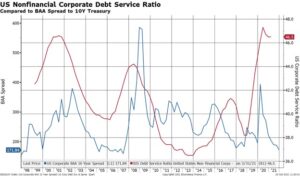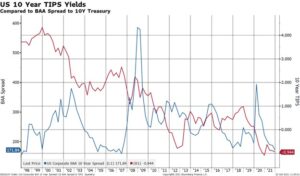By Bryce Coward, CFA, Knowledge Leaders Capital
By now investors are quite aware of the consequences of financial repression via negative real interest rate policies. Since interest rates on “risk free” government debt are too low to even compensate for inflation, it pushes investors out the risk spectrum in an effort to achieve a positive rate of return after inflation. So, it should come as no surprise that yield spreads between risky assets like corporate debt and US Treasury bonds would narrow in a financial repression. Interestingly, though, we may have reached the point where the link between corporate fundamentals and corporates credit spreads is broken, and that the overriding factor in pricing credit risk is the level of real interest rates.
For example, as the first chart below shows, the debt service ratio (interest expense as a percent of sales) for the US non-financial sector reached an all-time high in 2020 and has only improved marginally since then, despite the dramatic fall in the level of interest rates since 2018. At the same time, the spread between investment grade corporate yields and the 10 year US Treasury yield has narrowed to nearly an all-time low. Typically, there is at least a directional relationship between the corporate debt service ratio and credit spreads.
As the second chart shows, though, the overriding factor in the level of credit spreads has in recent years been the level of real interest rates, proxied here by 10 year TIPS yields. Since TIPS yields remain near all-time lows, we suppose it “makes sense”, in a convoluted way, that credit spreads are pricing an absurdly low level of credit risk.
If this isn’t the epitome of a negative real interest rate policy, we don’t know what is.















